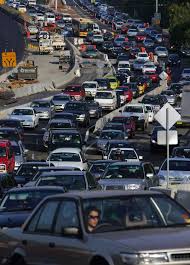
Forbes released their annual most congested cities and worst intersections list today.
Intersections
Most Congested Cities
Of the top five most congested cities, in order are; LA, NYC, Chicago, Dallas, DC.
The study found that the worst hour to drive in was 5pm on Thursday for LA and 5pm Friday on Friday for NYC. The report also discusses trends about how congestion has fallen for all cities compared to the 2008 results and that a slower economy could lead to a faster commute. Keep in mind, that is not an appropriate TDM tool.
Notably some cities TDM tools have worked, Atlanta, reduced congestion by 36% with suburban park and ride initiatives funded by federal dollars.
As for intersections, the Hollywood Freeway has 11 of the top 100 worst interchanges.
1 comment:
I find it very interesting looking at the chart/detail of the 100 Worst Intersections. What I noticed, though, is that this list is very misleading--the listed intersections are likely the worst points of congestion, but the congestion is not DUE TO the interchange/intersection. If you look at #12, Northbound US 101 / Santa Ana Fwy, the intersection listed is "Los Angeles Street"-- there is no northbound access to Los Angeles Street! The only NB access is FROM Los Angeles and Alameda Streets, a combined entrance. I also noticed Spring St. is listed for the 101 as well. This is a northbound exit only, so I really doubt the Spring St. interchange is "responsible" for any congestion seeing as it could only remove vehicles from the freeway, and it is a simple diverge, no weaving or anything involved.
Since I am very familiar with the 101 through Downtown, my guess is that these points encounter the slowest speeds and/or worst "congestion," but the congestion is actually resulting from a point further north, my guess being the Four Level Stack (Bill Keane Memorial Interchange) with the 110. Between the tight weaving conditions exhibited on the northbound lanes between the Broadway onramp, Grand Ave. offramp and the 110 connector, as well as the weave between Grand Ave. access to the 110, AND the complete stops that are often experienced on the 3rd level ramp of the interchange (resulting, in turn, from the 101 traffic trying to merge from 4 lanes into the 110's 3 thru traffic lanes, coupled with SB 110 traffic trying to weave to reach the Downtown exits), I would pinpoint the Harbor Fwy's configuration south of the Stack as the source of the congestion experienced through the heart of Downtown. The ancient ramp design/layout of the 101 further "north" also compounds the situation, but my gut tells me the 101 throughout Downtown is adversely affected primarily by the "7 turns to 3 lanes" setup of the Harbor Fwy south of the 101.
Very interesting data overall, but I think the analysis is lacking. Many things to investigate here, fer sher.
Post a Comment